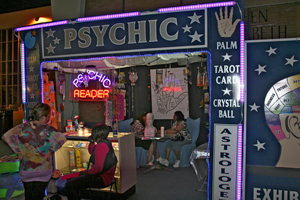
Source: Clock, scholz, Flickr
When I was in middle school, my mother came into my room every morning to tell me it was time to get up. I know that lots of my friends had to get up by themselves, but I never thought about getting ready for school by myself. Then everything changed. One day my father gave me an alarm clock. He said that from now on I could take responsibility in the morning.
Did that paragraph get you interested in reading more? Did you connect with it? Did it make you laugh or smile? Did it make you cringe or feel sympathy? Maybe it did one or more of those things. This introductory paragraph isn’t bad, but it’s very ordinary. If you are serious about your writing, ordinary will not be good enough. This introduction establishes the context and clearly introduces the thesis idea: “An alarm clock helped me take responsibility for myself in the morning.”

Source: Introduction day for international students, Universitetet I Bergen, Flickr
If this was part of your essay and you asked a friend to read your essay and suggest changes, your friend might not say anything about this paragraph needing to be changed. There is nothing wrong with it that must be corrected. It’s just that it’s not very effective. It’s ordinary, maybe even a little boring.
So what can you do? It would be nice if this paragraph introduced not only the topic and the main idea of the essay but also the personality of the essay. As it stands, the paragraph might as well have been written by a robot. We want to feel that a real person is behind this; we want to hear tone or attitude.
There are many, many ways to begin an essay. This section will describe and let you to practice three strategies. As you work with these strategies, you should develop a sense of what makes a good introduction. You should also get a sense of what gives personality to an introduction. When you begin to understand what is needed for a good introduction, then you can use other strategies beyond these three and even invent some of your own.
Use dialogue. Have you ever seen a written text start with dialogue? If you said no, you haven’t been paying attention to this lesson, which started with dialogue. The first sentences of the lesson introduction are “Hallelujah! I’m finished.” “Finished with what?” “I’m finished with my essay.”
Use an anecdote. An anecdote is a brief story. We could have started this lesson with an anecdote instead of the dialogue. We could have begun with this:

Source: cry, egg on stilts, Flikr
Seriously, I started to cry. I had worked for three days on that essay. When I got it back, the teacher had written “Very good start. Revise it carefully, and hand it back in tomorrow.” So I stayed after class and asked her what was wrong with it. I wanted to know what I needed to correct. She said the introduction was rather ordinary, for one thing. Also she said that the conclusion was an uninteresting restatement of the main idea. What did she want, excitement and drama? I was just writing an essay.

Source: Psychic reading, Gunnshots (Don), Wikimedia
Be a mind reader. Using the mind-reader strategy, you begin by presuming what is in a reader’s mind concerning your topic. You then surprise the reader by introducing a new idea (your thesis) that contrasts with those presumed ideas. An introduction for this lesson using the mind-reader strategy might go like this:
You probably think that revision is the same as correction. You probably think a writer only revises when there’s something wrong with the writing. You might even think that good writers get it right the first time. Am I right? Well, if you do think this way, you are wrong. Revision isn’t just correction, it isn’t just for writing that has errors, and it isn’t just for bad writers. In fact, some people would say that the difference between a good writer and an average one is how well the writer revises.
Practice with dialogue in introductions
For each of the practice exercises that follow, we’ll use the topic of “helping people out.” A model of an introduction using dialogue appears below. Read the model, and then try your hand at revising the ordinary introduction (about the alarm clock) at the beginning of this section. You will write your version using a graphic organizer. More instructions follow the model introduction.
Here’s a model introduction for an essay about helping people out that uses dialogue:
“Oh wow, did you see that? That guy really ate it on those stairs.”
“Yeah, I see. Oh no, his backpack came open, and the wind is scattering his papers.”
“This is crazy. I’m glad I’m not him right now.”
“Should we go over and help?”
“Nah. I’ve got to get to class. It’s not our problem.”
“Yeah, you’re right.”
This didn’t actually happen to me. But it could have. I would have been the guy who said, “I’ve got to get to class.” That’s how I felt about helping people out two years ago, but since then I have grown up, at least a little. I now think about situations like this a little differently because of something that my mother told me. I now think that it is “my problem.” I think that helping other people out when I can is just the right thing to do.
Use this model to help you revise the “alarm clock” introduction from the beginning of this section. As you revise, pay attention to the transition from the dialogue to the thesis statement. You can’t abruptly jump from the dialogue to your main idea. In the previous example, the writer used four sentences to connect the dialogue to the statements about his or her attitude toward helping people.
When you are finished revising, click below to see how one student revised.
“Roberto, are you awake? It’s time to get up. Come on, Roberto, get up. I’ve got to get to work. Roberto!”
“Yes. OK. I’m getting up.”
“Please, hurry. You’re making me late.”
“OK. OK. I’m up.”
When I was in middle school, my mother came into my room every morning to tell me it was time to get up. I knew that lots of my friends had to get up by themselves, but I never thought about getting ready for school by myself. Then everything changed. One day my father gave me an alarm clock. He said that from now on I could take responsibility in the morning.
Most of the ordinary introduction is unchanged—and you might find some ways to improve the part that stayed the same. However, the feel of the introduction is very different from the ordinary version, even though only the beginning changed. Dialogue lends the writing more interest, drama, and personality.
Practice with anecdotes in introductions
If dialogue does not appeal to you, try using an anecdote in the introduction as shown below. Read the model, and then try your hand at revising the ordinary introduction.
Here’s a model introduction about helping people out that uses an anecdote:

Source: ORANGES 0097, Myloismylife, Wikimedia
When I was in sixth grade, I liked to go to the grocery store with my mom. Once, something happened that I have never forgotten. It was really a very small thing, but it changed the way I felt about helping other people. My mom and I were in the produce section, and a man in front of us pulled an orange from the display. A small avalanche of oranges began, and they were soon bouncing around on the floor. I started laughing because it was, in fact, pretty funny. However, my mom immediately began to help him corral the oranges and put them back where they belonged. I still think things like this can be funny, but I have also learned a grown-up concern for people involved in small accidents like this one. Now I always try to help out if I can. It is just the right thing to do.
After writing a new version using an anecdote, click below to see how another student revised.
I heard my father’s car pull into our driveway. I didn’t know that he had a gift for me that was going to change my life. I was sitting in the living room watching a soccer game on television. My mother was talking on the telephone. When my father came in, he was smiling, holding a package. My mother got off the phone and asked him what he had. That was when he said it was a gift for me. Why? I wondered. It wasn’t my birthday or a holiday. I opened it and discovered an alarm clock. It was the old-fashioned kind that you see in cartoons, but I sort of liked it.
I had never had an alarm clock before. My mother came into my room every morning to tell me it was time to get up. I know that lots of my friends had to get up by themselves, but I never thought about getting ready for school by myself. Now everything had changed. From now on I could take responsibility in the morning.
The story you tell might be very different from this example. That is not the point. The thing to make note of is whether the story brings up the issue of responsibility, gets the reader interested in what you have to say, and has some personality.
Practice with mind reading in introductions
Here is a model of an introduction using the mind-reading strategy. Read the model and try your hand at revising the ordinary introduction from the beginning of this section.
Model introduction for an essay about helping people out:

Source: Sharing, Arty Smokes, Flickr
You probably think all teenagers are self-involved and inconsiderate of others. You would probably be surprised to see a teenager help someone get some bulky groceries into a car. You probably don’t think that teenagers would ever pick something up to return it to a person who dropped it or share an umbrella with someone in the rain. I’m a teenager, and I will admit that I sometimes used to act like this. But something that my mother explained to me changed my mind about helping other people out. Now, I think that helping other people out when I can is just the right thing to do.
After writing a new version using mind reading, click below to see how another student revised.
You might look at me and think, “There’s a boy who can take care of himself.” I probably seem like a pretty independent guy. I’ll bet you imagine me managing my life in a fairly adult way. I hope this is how I come across, because today it is more or less accurate. However, when I was in middle school, it was not accurate at all. I was perfectly happy letting someone else take care of me. It was usually my mother who worried about what my schedule was, which forms I needed to fill out, which assignments were due in my classes, and even when I woke up.
The first thing to change was getting up in the morning. One day my father gave me an alarm clock. He said that from now on I could take responsibility in the morning. I was surprised that I liked the idea, but I did. From that change came others, and now I truly am the boy who makes you say, “There’s someone who can take care of himself.”
Notice that this introduction uses the mind-reading strategy at the end of the introduction as well as at the beginning. Notice also that it broadens the idea of “responsibility” by using several general examples: “my schedule, which forms I needed to fill out,” and so on.
We have practiced three strategies to improve ordinary introductions. There are many more possibilities. When you read essays written by your classmates or by professional authors, notice how each author writes introductions. Try out new ways to revise introductions.